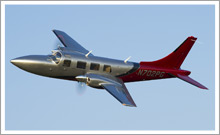| ||||
| | FT News | INSIDE AOPA | TRAINING PRODUCTS | FINAL EXAM | |||
TRAINING TIPs Updating emergency plans Or is there? You know what would happen if your instructor ever caught you looking so content. She would ease the throttle to idle and say, “Uh-oh, looks like someone is having engine trouble.” No such frantic drill today—but let those past exercises shape your thought process now. What options would be available if it became necessary right now, or a few minutes from now, to get on the ground? Always having a field, road, or other landing spot within glide range of your present position picked out is just part of the project. Inspecting the approach for obstructions, and assessing surface conditions, is another part. And how much maneuvering would be needed to approach into the wind? What evidence have you been noticing of surface wind speed and direction? “Smokestacks, trees, and bodies of water may offer information on changes in surface wind speed and direction until the airport windsock comes into view,” explained the Sept. 10 “ Training Tip: Wind awareness aloft.” Would you arrive over your intended landing spot with surplus altitude, or would it be a close call? Delay using flaps until there’s no question; this would be a time to consider using a forward slip to a landing. That’s a maneuver you will demonstrate on the private pilot practical test. No good landing site available? Let that scenario shape your thinking too. “One problem with making forced landings is that pilots may be unintentionally biased by their training,” Robert N. Rossier explained in this article about emergency landings. “For safety reasons, instructors use a good field when practicing emergency landings. In the real world, Murphy's Law almost guarantees that an engine failure will occur at low altitude over inhospitable terrain.” Throughout your emergency drills and exercises, there is one overriding consideration, the Air Safety Institute’s Emergency Procedures Safety Advisor reminds you. Fly the airplane! “Troubleshoot, talk to ATC, calm the passengers—whatever you have to do … but remember that it’s all for naught if you lose control of the airplane in the process.” The Air Safety Institute’s Emergency Procedures safety quiz also can help you be on top of your game. YOUR PARTNER IN TRAININGIf you could talk one on one with an air traffic controller, what would you ask? The Air Safety Institute’s new video series, “Ask ATC,” sits you down with a controller to delve into the most intriguing topics affecting today’s pilots. View the series on AOPA Online.
Did you know that student pilots who join AOPA are three times more likely to complete their flight training? Membership includes unlimited access to aviation information by phone (800/USA-AOPA, weekdays from 8:30 a.m. to 6 p.m. Eastern time) or from Flight Training Online or AOPA Online. If you're not already a member, join today and get the pilot’s edge. Login information is available online. FLIGHT TRAINING NEWSAOPA launches two training scholarshipsTwo new $5,000 AOPA scholarships will help two student pilots pursue a sport, recreational, or private pilot certificate. Applications for the two scholarships are being accepted online. The deadline for application is Aug. 19. The scholarship winners will be announced at AOPA Aviation Summit in Hartford, Conn. Read more >> Are you a good communicator?Effective radio communication is a learned skill, and an essential one in today's airspace. Knowing what to say and how to say it requires practice, but also increases your confidence in the cockpit. Don't be shy. Take the Radio Communication safety quiz from the Air Safety Institute, sponsored by the AOPA Insurance Agency, and start conquering “mic fright.” Final push on Calif. flight training planThe moratorium on enforcing the California Private Postsecondary Education Act of 2009 on flight instruction is set to expire July 1, and AOPA is working with industry groups and the state legislature to ensure that a bill to exempt flight instructors permanently is signed into law. Legislation that would fix the problem was approved by the California Senate in May. Read more >> New product aims to keep students, CFIs safeA new data tracking system, marketed exclusively to flight school owners, combines a fleet tracking solution with an inexpensive and effective debrief tool for CFIs and students. The system consists of a small, cell-phone-like device that mounts to the glareshield, an outdoor Wi-Fi access point, and a website. Read more >> Alaska pilots simulate off-airport landingsAviation groups in Alaska have teamed up with the FAA to offer local pilots a chance to practice max-performance takeoffs and landings at two airports. An experimental program launched in June lets pilots practice off-airport landings on simulated short gravel surfaces that are marked-off portions of longer gravel runways. Read more >> Teachers Day at AirVentureAny teacher who has searched for ways to blend the fun and excitement of aviation with the unmatched ability to educate young learners in science, history, and mathematics may soon have an opportunity to get the ball rolling. On July 26, the nonprofit aviation education organization Build A Plane will hold its third annual Teachers Day at AirVenture 2011 in Oshkosh, Wis. Read more >> Inside AOPAKnow before you goUnfortunately there are no “sky signs” to guide us through airspace. Yet it is our responsibility to understand and apply the rules that govern the sky. Find your way safely through the airspace maze with the Air Safety Institute’s Know Before You Go: Navigating Today’s Airspace interactive online course. From basic chart interpretation to understanding temporary flight restrictions or special flight rule areas, you’ll be armed with important navigation knowledge before takeoff. The course qualifies for AOPA Accident Forgiveness and the FAA Wings program. Tips for finding a good aviation medical examinerFinding a good aviation medical examiner is like finding a good mechanic for an aircraft owner—when you finally strike a balance with the right doctor, it can become a long and happy relationship. AOPA Director of Medical Certification Gary Crump offers tips and tools to help your search be successful. Read more >> AOPA member recoups his dues paymentDavid Strother joined AOPA in 1961 after earning his pilot certificate. When he paid his $45 dues this year, he had no idea that it was going to turn out to be such a savvy investment. Recently he checked into a car rental with Hertz and was told that the entire rental would cost $958. Nothing remarkable about that, until you know that with his AOPA discount, the rental cost dropped to $794. Read more >> TRAINING PRODUCTSBuild your own RAM mount system with Aircraft SpruceDo you have a handheld GPS, iPad, or other electronic device that needs a mount? Not sure which type of mount will work best for the gadget, or for your airplane? Aircraft Spruce now lets you design a custom RAM mount system right on its website. Select the device to be secured, and the required adaptor is automatically added to your list. Then choose an arm and a base. The items are added to your shopping cart, ready for checkout.
Note: Products listed have not been evaluated by ePilot editors unless otherwise noted. AOPA assumes no responsibility for products or services listed or for claims or actions by manufacturers or vendors. FINAL EXAMQuestion: Can I change the weight of an experimental amateur-built airplane that I have built so it meets the 1,320-pound weight limit for light sport aircraft?
Answer: As the builder of an amateur-built airplane that has not yet received its experimental airworthiness certificate, you may decrease or increase the weight as necessary to have the airplane meet the definition of light sport aircraft, which is defined in FAR Part 1 as having a maximum gross weight of 1,320 pounds for aircraft not intended for operation on water. The weight limit is increased to 1,430 pounds for water operations. However, once a weight limit has been set as part of the airplane's experimental amateur-built certification, the original builder, future owners, and repairmen are prohibited from making any modifications to the weight for the purpose of meeting the definition of light sport aircraft. For more information, read the subject report Sport Pilot and Light Sport Aircraft on AOPA Online.
Got a question for our technical services staff? Email [email protected] or call the Pilot Information Center, 800/872-2672. Don’t forget the online archive of “Final Exam” questions and answers, searchable by keyword or topic. What’s New OnlineAre you going to AirVenture in Oshkosh, Wis.? If you’re still on the fence, AOPA Associate Editor Jill Tallman explains why you need to be there in this week’s Flight Training blog. AOPA Career OpportunitiesEver dream of turning your passion for aviation into a career? We’re looking for an application support engineer, Dot Net developer, and electronic advertising manager. To learn more about other AOPA career opportunities, visit AOPA Online. Picture Perfect AVIATION EVENTS & WEATHER To include an event or to search all events in the calendar, visit AOPA Online. For airport details, including FBO fuel prices, see AOPA Airports. Flight Instructor Refresher ClinicsThe next Air Safety Institute Flight Instructor Refresher Clinics are scheduled in Phoenix, Ariz., and Ashburn, Va., June 25 and 26; Memphis, Tenn., July 9 and 10; Jacksonville, Fla., July 16 and 17; and Newark, N.J., and Pittsburgh, Pa., July 23 and 24. For a complete schedule, see AOPA Online.
Can’t make it in person? Sign up for the CFI Refresher Online. Air Safety Institute Safety SeminarsAir Safety Institute Safety Seminars are scheduled in Oshkosh, Wis., July 27 through 29; and Germantown, Tenn., Wichita, Kan., Fort Worth, Texas, and West Houston, Texas, Sept. 12. | Advertisers Got news? Contact ePilot. Having difficulty using this service? Visit the ePilot Frequently Asked Questions now at AOPA Online or write to [email protected]. |
| Member Tools : Send feedback | ePilot Archive Editorial Team: ePilot Flight Training Editor : Jill W. Tallman | ePilot Editor: Sarah Brown | Contributor: Alton K. Marsh |

 You took off on your solo cross-country flight, leveled off, turned on course, and set the power and mixture. Your first checkpoint showed up on time—and you even found time to give the engine instruments a glance. Nothing to do now except hold course and admire the view.
You took off on your solo cross-country flight, leveled off, turned on course, and set the power and mixture. Your first checkpoint showed up on time—and you even found time to give the engine instruments a glance. Nothing to do now except hold course and admire the view.


